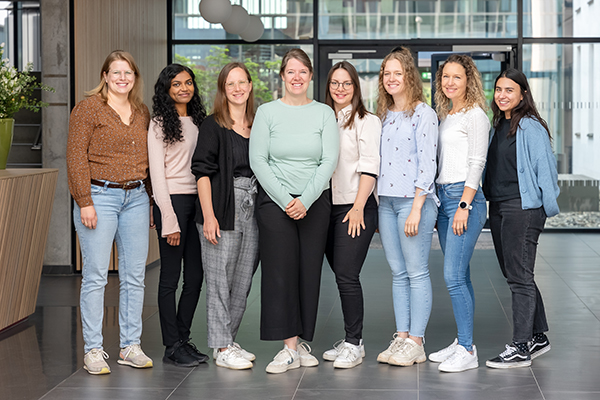Our Diagnostic Panel for Skeletal Diseases enables comprehensive genetic diagnostics for skeletal diseases, which are often difficult to distinguish from each other due to their genetic causes. The human skeleton consists of more than 200 bones and provides the central support function for the body. To ensure a reliable and rapid diagnosis, the panel covers all relevant genes for various skeletal disease groups, such as skeletal dysplasias, osteogenesis imperfecta (brittle bone disease), and limb malformations.
The Diagnostic Panel for Skeletal Diseases is based on our proprietary, high-quality ExomeXtra® enrichment, covering all protein-coding regions as well as intronic and intergenic variants described as disease-relevant in the databases HGMD and ClinVar. In addition, the ExomeXtra® enrichment enables a genome-wide CNV calling with similar performance to array CGH. It thus provides the ideal basis for genetic diagnostics.
Are you insured in Germany? Our colleagues at the Zentrum für Humangenetik Tübingen will gladly advise you!
What We Offer with the Panel for Skeletal Disorders
Our Promise to You
Your Benefits
It is possible to request single or multiple predefined gene sets. In addition to the complete analysis of the genes of the requested gene set, we extend the analysis by additional genes for differential diagnosis. We report variants of unknown significance (ACMG class 3) and pathogenic and probably pathogenic variants (ACMG classes 4 and 5) for the primarily ordered gene set. For the genes included due to differential diagnosis, we restrict the reporting to pathogenic and probably pathogenic variants (ACMG classes 4 and 5), which could be related to the indication of the person seeking advice.
The Diagnostic Panel for Skeletal Disorders is based on CeGaT’s ExomeXtra® enrichment. This allows, without additional sequencing, phenotypically eligible gene sets of other CeGaT panels or single genes to be additionally ordered. If you would like to assemble an individual panel, please feel free to contact us. We will be happy to support you.
In addition to the primary diagnostic assignment, the assessment of ACMG genes and pharmacogenetic profiling may also be ordered.
Method
The enrichment of the coding regions and the adjacent intronic regions is performed using an in-solution hybridization technology. The selection of the targeted regions and the design of the enrichment baits is performed in-house. High-throughput sequencing is performed on our Illumina platforms. Bioinformatic processing of the data is achieved using an in-house computer cluster.
Following data processing, our team of scientists and specialists in human genetics analyze the data and issue a medical report.
Sample Report
Information: The example report on epilepsy and brain development disorders illustrates how a report is structured.
General Information
Material
- 1-2 ml EDTA blood (recommended sample type) or
- 1-2 µg genomic DNA
- Order Form with declaration of consent
Here you can find more information on how to ship your sample safely.
Costs
The prices for our human genetic diagnostics depend on the size of the selected diagnostic panel and the selected gene sets. All prices include sequencing, bioinformatic analysis, and issuing of a medical report by our team of experts in human genetic diagnostics.
Gene Sets – Skeletal Disorders
Spondylometaphyseal Dysplasia and Spondylo-Epi-(Meta)- Physeal Dysplasia (SKT03, 51 Genes)
ACAN, ACP5, B3GALT6, B3GAT3, B4GALT7, BPNT2, CANT1, CCN6, CFAP410, CHST3, COL11A1, COL11A2, COL2A1, COL9A1, COL9A2, COL9A3, CSGALNACT1, DDR2, DYM, EIF2AK3, EXTL3, FLNB, FN1, GZF1, HSPA9, HSPG2, IARS2, INPPL1, KIF22, LONP1, MBTPS1, NANS, NEPRO, NKX3-2, PAPSS2, PCYT1A, PISD, POP1, RAB33B, RMRP, RNU4ATAC, RSPRY1, SLC10A7, SLC39A13, SMARCAL1, TMEM165, TONSL, TRAPPC2, TRIP11, TRPV4, XYLT1
Micromelic Dysplasia: Acromelic, Acromesomelic, Mesomelic and Rhizo-Mesomelic Dysplasia (SKT04, 21 Genes)
ADAMTS10, ADAMTS17, ADAMTSL2, BMPR1B, DONSON, DVL1, DVL3, FBN1, FZD2, GDF5, GPC6, IHH, LTBP3, NPR2, PDE4D, PRKAR1A, ROR2, SHOX, SMAD4, TRPS1, WNT5A
Short-Rib Dysplasia (SKT05, 26 Genes)
C2CD3, CEP120, CFAP410, CILK1, CSPP1, DYNC2H1, DYNC2I1, DYNC2I2, DYNC2LI1, DYNLT2B, EVC, EVC2, IFT122, IFT140, IFT172, IFT43, IFT52, IFT80, IFT81, INTU, KIAA0586, KIAA0753, NEK1, TTC21B, WDR19, WDR35
Osteogenesis Imperfecta and Related Skeletal Dysplasias with Decreased Bone Density (SKT07, 30 Genes)
ALPL, ANO5, B3GALT6, B4GALT7, BMP1, COL1A1, COL1A2, CREB3L1, CRTAP, FKBP10, GORAB, IFITM5, KDELR2, LRP5, MESD, P3H1, P4HB, PLOD2, PLS3, PPIB, SEC24D, SERPINF1, SERPINH1, SGMS2, SP7, SPARC, TENT5A, TMEM38B, TNFRSF11B, WNT1
Osteopetrosis and Related Skeletal Dysplasias with Increased Bone Density (SKT08, 26 Genes)
AMER1, ANKH, CA2, CLCN7, CTSK, DLX3, FAM20C, FERMT3, GJA1, HPGD, LEMD3, LRP5, LRRK1, OSTM1, PLEKHM1, PTDSS1, SFRP4, SLCO2A1, SNX10, SOST, TBXAS1, TCIRG1, TGFB1, TNFRSF11A, TNFRSF11B, TNFSF11
Hypophosphatemic Rickets and Related Skeletal Dysplasias with Abnormal Mineralization (SKT09, 17 Genes)
ALPL, ANKH, CASR, CLCN5, CYP27B1, CYP2R1, CYP3A4, DMP1, ENPP1, FAM20C, FGF23, PHEX, PTH1R, SLC34A1, SLC34A3, TRPV6, VDR
Limb Malformations: Isolated Brachydactyly, Synostoses, Split-Hand/Foot, Polydactyly, Syndactyly, and Selected Genetic Syndromes with Limb Malformations (SKT10, 78 Genes)
ARHGAP31, ARID1A, ARID1B, ARID2, BHLHA9, BMP2, BMPR1B, CCNQ, CDH3, CHSY1, CREBBP, DHODH, DLL4, DLX5, DOCK6, DPF2, EFNB1, EFTUD2, EOGT, EP300, ESCO2, EVC2, FGF10, FGF16, FGF9, FGFR1, FGFR2, FGFR3, GDF5, GDF6, GJA1, GLI1, GLI2, GLI3, HDAC8, HOXA13, HOXD13, IHH, IQCE, KIAA0825, KIF7, LMBR1, LRP4, MECOM, MYCN, NAA10, NIPBL, NOG, NOTCH1, PAX3, PDE3A, PDE4D, PRKAR1A, PTHLH, RAD21, RBM8A, RBPJ, RECQL4, ROR2, SALL1, SALL4, SF3B4, SMARCA4, SMARCB1, SMARCE1, SMC1A, SMC3, SMOC1, SOX11, TBX15, TBX3, TBX4, TBX5, TP63, TRPV4, WNT10B, WNT7A, YY1AP1
Craniosynostosis (SKT11, 34 Genes)
ALPL, ASXL1, BPNT2, CDC45, COLEC11, CYP26B1, EFNB1, ERF, ESCO2, FGFR1, FGFR2, FGFR3, FREM1, IFT122, IFT140, IFT43, IL11RA, KAT6A, MASP1, MEGF8, MSX2, P4HB, POR, RAB23, RECQL4, SCARF2, SEC24D, SKI, SMAD6, TCF12, TWIST1, WDR19, WDR35, ZIC1
Potentially Lethal Skeletal Disorders (SKT12, 51 Genes)
AGPS, ALPL, ARSL, BMPER, CANT1, CEP120, CILK1, COL11A1, COL11A2, COL1A1, COL1A2, COL2A1, CRTAP, CSPP1, DHCR7, DLL3, DYNC2H1, DYNC2I2, DYNC2LI1, EBP, FAM111A, FAM20C, FGFR2, FGFR3, FLNA, FLNB, GDF5, GNPAT, IFT80, INPPL1, INTU, KIAA0586, KIAA0753, LBR, LIFR, MESD, NEK1, NSDHL, OFD1, P3H1, PEX7, PPIB, PTH1R, RNU4ATAC, SLC26A2, SLC35D1, SNRPB, SOX9, TCTN3, TRIP11, TRPV4
Seckel Syndrome, 3-M Syndrome, Rubinstein–Taybi Syndrome, Kabuki Syndrome, and Further Selected Genetic Syndromes with Skeletal Involvement (SKT13, 27 Genes)
ASXL1, ATR, CCDC8, CENPJ, CEP152, CHD7, CREBBP, CUL7, DNA2, DONSON, EP300, FLNA, KDM6A, KMT2D, LARP7, MAP3K7, OBSL1, PCNT, PHGDH, PIK3R1, PLK4, POC1A, PSAT1, SEMA3E, SH3PXD2B, TRAIP, XRCC4
Lysosomal Storage Disorders with Skeletal Involvement (SKT14, 22 Genes)
AGA, ARSB, CTSA, FUCA1, GALNS, GLB1, GNPTAB, GNPTG, GNS, GUSB, HGSNAT, HYAL1, IDS, IDUA, MAN2B1, MANBA, NAGLU, NEU1, SGSH, SLC17A5, SUMF1, VPS33A
Craniofacial and Patellar Dysostoses; Dysostoses with Vertebral and Costal Involvement: Klippel-Feil Syndrome, Meier-Gorlin Syndrome, and Related Disorders (SKT15, 39 Genes)
ABCC9, ALX3, ALX4, BMPER, C2CD3, CDC45, CDT1, DHODH, DLL3, DONSON, EFNB1, EFTUD2, EVC2, GDF3, GDF6, GNAI3, HES7, KAT6B, LFNG, LMX1B, MEOX1, MESP2, MNX1, MYO18B, OFD1, ORC1, ORC4, ORC6, PDE4D, PLCB4, POLR1C, POLR1D, PRKAR1A, SF3B4, SNRPB, TBX4, TBX6, TCOF1, TMCO1
Gene Directory – Panel for Skeletal Disorders
ABCC9, ACAN, ACP5, ADAMTS10, ADAMTS17, ADAMTSL2, AGA, AGPS, ALPL, ALX3, ALX4, AMER1, ANKH, ANO5, ARHGAP31, ARID1A, ARID1B, ARID2, ARSB, ARSL, ASXL1, ATR, B3GALT6, B3GAT3, B4GALT7, BHLHA9, BMP1, BMP2, BMPER, BMPR1B, BPNT2, C2CD3, CA2, CANT1, CASR, CCDC8, CCN6, CCNQ, CDC45, CDH3, CDKN1C, CDT1, CENPJ, CEP120, CEP152, CFAP410, CHD7, CHST3, CHSY1, CILK1, CLCN5, CLCN7, COL10A1, COL11A1, COL11A2, COL1A1, COL1A2, COL2A1, COL9A1, COL9A2, COL9A3, COLEC11, COMP, CREB3L1, CREBBP, CRTAP, CSGALNACT1, CSPP1, CTSA, CTSK, CUL7, CYP26B1, CYP27B1, CYP2R1, CYP3A4, DDR2, DHCR7, DHODH, DLL3, DLL4, DLX3, DLX5, DMP1, DNA2, DNAJC21, DOCK6, DONSON, DPF2, DVL1, DVL3, DYM, DYNC2H1, DYNC2I1, DYNC2I2, DYNC2LI1, DYNLT2B, EBP, EFL1, EFNB1, EFTUD2, EIF2AK3, ENPP1, EOGT, EP300, ERF, ESCO2, EVC, EVC2, EXT1, EXT2, EXTL3, FAM111A, FAM20C, FBN1, FERMT3, FGF10, FGF16, FGF23, FGF9, FGFR1, FGFR2, FGFR3, FIG4, FKBP10, FLNA, FLNB, FN1, FREM1, FUCA1, FZD2, GALNS, GDF3, GDF5, GDF6, GJA1, GLB1, GLI1, GLI2, GLI3, GNAI3, GNPAT, GNPTAB, GNPTG, GNS, GORAB, GPC6, GUSB, GZF1, HDAC8, HES7, HGSNAT, HOXA13, HOXD13, HPGD, HSPA9, HSPG2, HYAL1, IARS2, IDS, IDUA, IFITM5, IFT122, IFT140, IFT172, IFT43, IFT52, IFT80, IFT81, IHH, IL11RA, INPPL1, INTU, IQCE, KAT6A, KAT6B, KDELR2, KDM6A, KIAA0586, KIAA0753, KIAA0825, KIF22, KIF7, KMT2D, LARP7, LBR, LEMD3, LFNG, LIFR, LMBR1, LMX1B, LONP1, LRP4, LRP5, LRRK1, LTBP3, MAN2B1, MANBA, MAP3K7, MASP1, MATN3, MBTPS1, MECOM, MEGF8, MEOX1, MESD, MESP2, MGP, MMP13, MMP9, MNX1, MSX2, MYCN, MYO18B, NAA10, NAGLU, NANS, NEK1, NEPRO, NEU1, NIPBL, NKX3-2, NOG, NOTCH1, NPR2, NSDHL, OBSL1, OFD1, ORC1, ORC4, ORC6, OSTM1, P3H1, P4HB, PAPSS2, PAX3, PCNT, PCYT1A, PDE3A, PDE4D, PEX7, PHEX, PHGDH, PIK3R1, PISD, PLCB4, PLEKHM1, PLK4, PLOD2, PLS3, POC1A, POLR1C, POLR1D, POP1, POR, PPIB, PRKAR1A, PSAT1, PTDSS1, PTH1R, PTHLH, RAB23, RAB33B, RAD21, RBM8A, RBPJ, RECQL4, RMRP, RNU4ATAC, ROR2, RSPRY1, RUNX2, SALL1, SALL4, SBDS, SCARF2, SEC24D, SEMA3E, SERPINF1, SERPINH1, SF3B4, SFRP4, SGMS2, SGSH, SH3PXD2B, SHOX, SKI, SLC10A7, SLC17A5, SLC26A2, SLC34A1, SLC34A3, SLC35D1, SLC39A13, SLCO2A1, SMAD4, SMAD6, SMARCA4, SMARCAL1, SMARCB1, SMARCE1, SMC1A, SMC3, SMOC1, SNRPB, SNX10, SOST, SOX11, SOX9, SP7, SPARC, SRP54, SUMF1, TBX15, TBX3, TBX4, TBX5, TBX6, TBXAS1, TCF12, TCIRG1, TCOF1, TCTN3, TENT5A, TGFB1, TMCO1, TMEM165, TMEM38B, TNFRSF11A, TNFRSF11B, TNFSF11, TONSL, TP63, TRAIP, TRAPPC2, TRIP11, TRPS1, TRPV4, TRPV6, TTC21B, TWIST1, VDR, VPS33A, WDR19, WDR35, WNT1, WNT10B, WNT5A, WNT7A, XRCC4, XYLT1, YY1AP1, ZIC1
Additional Services
HLA-Typing (HLA01)
HLA class I (Gene A, B, C) and HLA class II (Gene DPA1, DPB1, DQA1, DQB1, DRB1, DRB3, DRB4, DRB5)
ACMG Genes
Genetic variation may sometimes be identified, which does not fit within the scope of the requested genetic analysis (so-called secondary findings). The reporting of these variants is limited to pathogenic alterations (ACMG classes 4 and 5) within selected genes, for which a treatment or course of action exists for you or your family (according to the current guidelines of the American College of Medical Genetics and Genomics).
Pharmacogenetics
Pharmacogenetic analysis detects genetic changes that affect the effectiveness of drugs. Genetic variants that affect proteins responsible for the metabolism of substances can significantly change their tolerance and efficacy. These drugs include, among others, antidepressants, pain relievers, neuroleptics, chemotherapeutics, AIDS drugs, thrombosis drugs, anesthetics, beta-blockers, or statins.
The reduced activity of a specific enzyme can lead to an increased drug level in the standard dosage, which is often associated with undesirable side effects. With drugs that are only activated by metabolism, the therapeutic effect can be completely absent. Likewise, due to the resulting increased rate of degradation of the medicinal substance, an increased enzyme activity leads to inadequate effectiveness of the therapy.
The pharmacogenetics option analyzes known variants in twenty-one genes involved in the metabolism of drugs. If specific gene variants occur, the treating doctor can adapt the therapy individually. The pharmacogenetic analysis can minimize serious side effects and helps to avoid failure of the treatment.
Downloads
* The example report on epilepsy and brain development disorders illustrates how a report is structured.
Contact Us
Do you have a question, or are you interested in our service?
Diagnostic Support
We will assist you in selecting the diagnostic strategy – for each patient.




